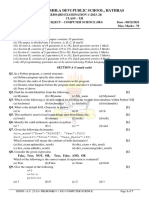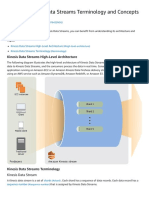Master these to crack any SQL interview!
Here are Top SQL Interview Questions for Beginners with Clear Example
1️) What is the difference between WHERE and HAVING?
• WHERE filters rows before grouping.
• HAVING filters after aggregation.
SELECT department, COUNT(*)
FROM employees
WHERE salary > 50000
GROUP BY department
HAVING COUNT(*) > 5;
2) How to find the second highest salary?
SELECT MAX(salary)
FROM employees
WHERE salary < (SELECT MAX(salary) FROM employees);
3) What is a NULL? How do you handle it?
• NULL = unknown/missing value.
• Use IS NULL or COALESCE().
SELECT name, COALESCE(phone, 'N/A') FROM users;
4) Difference between INNER JOIN, LEFT JOIN, RIGHT JOIN, and FULL JOIN?
Example:
SELECT *
FROM orders o
LEFT JOIN customers c ON o.customer_id = c.id;
5) What is a subquery? Types?
• Single-row
• Multi-row
• Correlated
SELECT name
FROM employees
WHERE dept_id = (SELECT id FROM departments WHERE name = 'IT');
6) What are window functions?
SELECT name, salary,
RANK() OVER (ORDER BY salary DESC) AS salary_rank
FROM employees;
7) Difference between RANK(), DENSE_RANK(), and ROW_NUMBER()?
RANK() – Skips ranks
DENSE_RANK() – No gaps
ROW_NUMBER() – Unique order
8) How to retrieve duplicate records?
SELECT name, COUNT(*)
FROM students
GROUP BY name
HAVING COUNT(*) > 1;
9️) What is a primary key vs unique key?
• Primary Key: Unique + Not Null
• Unique Key: Just Unique
10) What is a foreign key?
• A key that references a primary key in another table to maintain referential integrity.
11) Difference between DELETE, TRUNCATE, and DROP?
• DELETE: Row-wise delete, rollback possible
• TRUNCATE: Faster, can't rollback
• DROP: Removes structure
12) How to select top N records?
SELECT * FROM employees ORDER BY salary DESC LIMIT 5;
13) How do you update data with a JOIN?
UPDATE e
SET e.salary = e.salary * 1.1
FROM employees e
JOIN departments d ON e.dept_id = d.id
WHERE d.name = 'IT';
14) What’s a CTE (Common Table Expression)?
WITH high_salary AS (
SELECT * FROM employees WHERE salary > 80000
)
SELECT * FROM high_salary WHERE dept_id = 2;
15) Find employees earning more than their manager.
SELECT e.name
FROM employees e
JOIN employees m ON e.manager_id = m.id
WHERE e.salary > m.salary;
1️6️) What is normalization?
• Process to reduce redundancy.
• 1NF, 2NF, 3NF, BCNF...
1️7️) What is denormalization?
• Adding redundancy for performance.
1️8️) What is indexing?
• Boosts read performance.
• Use on frequently filtered/sorted columns.
CREATE INDEX idx_salary ON employees(salary);
1️9) What’s the use of GROUP BY?
• Aggregation by categories.
SELECT dept_id, AVG(salary)
FROM employees
GROUP BY dept_id;
2️0️) What’s the difference between COUNT(*), COUNT(1), COUNT(column)?
• COUNT(*): All rows
• COUNT(1): Similar to COUNT(*)
• COUNT(column): Non-null values only
2️1️) What’s a correlated subquery?
SELECT name
FROM employees e
WHERE salary > (
SELECT AVG(salary)
FROM employees
WHERE dept_id = e.dept_id
);
2️2️) What is EXISTS vs IN?
• EXISTS – Faster for correlated subqueries
• IN – Works well for static lists
2️3️) What is the difference between UNION and UNION ALL?
• UNION: Removes duplicates
• UNION ALL: Includes all rows
2️4️) What is a stored procedure?
• A saved SQL logic block
CREATE PROCEDURE GetEmployees()
BEGIN
SELECT * FROM employees;
END;
2️5️) What is ACID in DB?
• Atomicity
• Consistency
• Isolation
• Durability
2️6️) How to get the nth highest salary?
SELECT DISTINCT salary
FROM employees e1
WHERE N-1 = (
SELECT COUNT(DISTINCT salary)
FROM employees e2
WHERE e2.salary > e1.salary
);
2️7️) What is a composite key?
• A primary key made up of 2+ columns.
PRIMARY KEY (order_id, product_id)
2️8️) What is a self join?
• Joining a table with itself.
SELECT A.name, B.name AS manager_name
FROM employees A
JOIN employees B ON A.manager_id = B.id;
2️9️) What are aggregate functions?
• SUM(), COUNT(), AVG(), MIN(), MAX()
3️0️) Difference between CHAR and VARCHAR?
• CHAR(n) – Fixed length
• VARCHAR(n) – Variable length
3️1️) How to remove duplicate rows?
DELETE FROM employees
WHERE id NOT IN (
SELECT MIN(id)
FROM employees
GROUP BY name, salary
);
3️2️) What’s the purpose of COALESCE()?
• Returns the first non-null value.
SELECT COALESCE(mobile, phone, 'No Contact') FROM users;
3️3️) What is the use of CASE statement?
SELECT name,
CASE
WHEN salary > 100000 THEN 'High'
WHEN salary > 50000 THEN 'Medium'
ELSE 'Low'
END AS salary_band
FROM employees;
3️4️) What is the default sorting order in ORDER BY?
• Ascending (ASC)
3️5️) Difference between BETWEEN and IN?
• BETWEEN – Continuous range
• IN – Specific values
3️6️) How to calculate cumulative sum?
SELECT name, salary,
SUM(salary) OVER (ORDER BY id) AS running_total
FROM employees;
3️7️) What’s the purpose of LIMIT and OFFSET?
SELECT * FROM employees
ORDER BY id
LIMIT 10 OFFSET 20;
3️8️) What is schema in SQL?
• Logical structure grouping tables, views, procedures.
3️9️) How to convert rows into columns (pivot)?
Depends on RDBMS. Example (PostgreSQL):
SELECT
department,
COUNT(*) FILTER (WHERE gender = 'M') AS male_count,
COUNT(*) FILTER (WHERE gender = 'F') AS female_count
FROM employees
GROUP BY department;
4️0️) What is the use of DISTINCT?
SELECT DISTINCT department FROM employees;
4️1️) What is a trigger?
• Auto-executed code when events occur.
CREATE TRIGGER log_salary_update
AFTER UPDATE ON employees
FOR EACH ROW
INSERT INTO audit_log(emp_id, old_salary, new_salary)
VALUES (OLD.id, OLD.salary, NEW.salary);
4️2️) Difference between OLTP and OLAP?
OLTP OLAP
Fast read/write Fast analysis
Normalized Denormalized
e.g., ATM e.g., Reporting tool
4️3️) How to find top 3 salaries per department?
SELECT *
FROM (
SELECT name, department, salary,
RANK() OVER (PARTITION BY department ORDER BY salary DESC) AS rnk
FROM employees
) sub
WHERE rnk <= 3;
4️4️) What is data type precision vs scale?
• DECIMAL(p, s)
• p = precision (total digits)
• s = scale (digits after decimal)
4️5️) What is ISNULL() vs IFNULL()?
• RDBMS specific null handling functions.
SELECT ISNULL(col, 0); -- SQL Server
SELECT IFNULL(col, 0); -- MySQL
46) What is TRANSACTION?
• Group of SQL steps executed as a unit.
BEGIN TRANSACTION;
UPDATE accounts SET balance = balance - 100 WHERE id = 1;
UPDATE accounts SET balance = balance + 100 WHERE id = 2;
COMMIT;
47) What’s the difference between CHARINDEX() and SUBSTRING()?
• CHARINDEX() – Position of substring
• SUBSTRING() – Extract part of string
48) What is a cross join?
• Cartesian product of two tables.
SELECT * FROM products CROSS JOIN colors;
49) What is SET vs SELECT INTO?
• SET assigns variables
• SELECT INTO creates new table
50) How to check for referential integrity violations?
SELECT *
FROM orders
WHERE customer_id NOT IN (SELECT id FROM customers);
51) What is the difference between TEMP and GLOBAL TEMP tables?
• TEMP: Session-specific
• GLOBAL TEMP: Visible to all sessions (until last session disconnects)
CREATE TEMP TABLE temp_sales (...);
52) What is the difference between IN, ANY, ALL, and EXISTS?
-- IN: list match
-- ANY: at least one match
-- ALL: all must match
-- EXISTS: subquery returns at least one row
53) How to find employees with no department?
SELECT *
FROM employees
WHERE dept_id IS NULL;
54) How to calculate age from date of birth?
SELECT name,
DATEDIFF(YEAR, dob, GETDATE()) AS age
FROM employees; -- SQL Server
-- MySQL
SELECT name, TIMESTAMPDIFF(YEAR, dob, CURDATE()) AS age FROM employees;
55) How to find all weekends in a given month?
(Example in PostgreSQL)
SELECT generate_series('2025-07-01'::date, '2025-07-31', '1 day')::date AS day
WHERE EXTRACT(DOW FROM day) IN (0, 6);
56) How to find customers who never placed an order?
SELECT *
FROM customers
WHERE id NOT IN (SELECT customer_id FROM orders);
57) How to reverse a string in SQL?
-- SQL Server
SELECT REVERSE('LinkedIn');
-- MySQL
SELECT REVERSE('LinkedIn');
58) What is a surrogate key?
• A system-generated unique key (like ID) not derived from data.
59) What is an alternate key?
• A candidate key not chosen as the primary key.
60) How to avoid divide-by-zero errors?
SELECT amount / NULLIF(quantity, 0) AS unit_price FROM orders;
61) What is the difference between TRIGGER and PROCEDURE?
• Trigger: Auto-executed
• Procedure: Manually invoked
62) How to calculate median salary?
SELECT AVG(salary) AS median_salary
FROM (
SELECT salary
FROM employees
ORDER BY salary
LIMIT 2 - (SELECT COUNT(*) % 2) OFFSET (SELECT (COUNT(*) - 1) / 2)
);
63) What is the difference between SCHEMA and DATABASE?
• Database: Collection of schemas
• Schema: Collection of tables, views, procedures inside DB
64) What is a materialized view?
• A view that stores query results physically (refreshed periodically).
65) How to compare two tables for mismatched data?
SELECT * FROM tableA
EXCEPT
SELECT * FROM tableB;
66) How to find common records between two tables?
SELECT * FROM tableA
INTERSECT
SELECT * FROM tableB;
67) What is a recursive CTE?
• A CTE that refers to itself (e.g., hierarchy or tree structure)
WITH RECURSIVE hierarchy AS (
SELECT id, name, manager_id FROM employees WHERE manager_id IS NULL
UNION ALL
SELECT e.id, e.name, e.manager_id
FROM employees e
JOIN hierarchy h ON e.manager_id = h.id
)
SELECT * FROM hierarchy;
68) What are the different types of indexes?
• Clustered
• Non-clustered
• Composite
• Unique
• Bitmap (Oracle)
69) How to find gaps in a sequence?
SELECT id + 1 AS missing
FROM employees e1
WHERE NOT EXISTS (
SELECT 1 FROM employees e2 WHERE e2.id = e1.id + 1
);
70) How to find 3rd occurrence of a character in a string?
-- SQL Server
SELECT CHARINDEX('-', column, CHARINDEX('-', column, CHARINDEX('-', column) + 1)
+ 1)
FROM table;
71) How to rank within groups?
SELECT name, department, salary,
RANK() OVER (PARTITION BY department ORDER BY salary DESC) AS dept_rank
FROM employees;
72) What is the difference between VARCHAR, TEXT, and NVARCHAR?
Type Use Case
VARCHAR ASCII text
NVARCHAR Unicode (multi-language)
TEXT Large strings (deprecated in some DBs)
73) How to export query results to a CSV?
• MySQL:
SELECT * INTO OUTFILE '/tmp/output.csv'
FIELDS TERMINATED BY ','
FROM employees;
74) How to find duplicates based on 2 columns?
SELECT col1, col2, COUNT(*)
FROM table
GROUP BY col1, col2
HAVING COUNT(*) > 1;
75) How to use MERGE statement (UPSERT)?
MERGE target_table AS target
USING source_table AS source
ON target.id = source.id
WHEN MATCHED THEN
UPDATE SET target.name = source.name
WHEN NOT MATCHED THEN
INSERT (id, name) VALUES (source.id, source.name);
76) What are the ACID properties of a transaction?
• Atomicity – All or nothing
• Consistency – DB stays valid
• Isolation – Concurrent-safe
• Durability – Once committed, changes persist
77) How to generate row numbers without ROW_NUMBER()?
SELECT a.id, COUNT(*) AS row_num
FROM employees a
JOIN employees b ON a.id >= b.id
GROUP BY a.id;
78) What is database sharding?
• Breaking large databases into smaller, faster, independent chunks across multiple machines.
79) How to get table metadata?
-- MySQL
DESCRIBE employees;
-- SQL Server
EXEC sp_help 'employees';
80) How to get column names from a table?
SELECT COLUMN_NAME
FROM INFORMATION_SCHEMA.COLUMNS
WHERE TABLE_NAME = 'employees';
81) How to remove duplicate rows but keep one?
DELETE FROM employees
WHERE id NOT IN (
SELECT MIN(id)
FROM employees
GROUP BY name, salary
);
82) What is the difference between HAVING and WHERE with example?
• WHERE filters rows
• HAVING filters aggregates
SELECT department, COUNT(*)
FROM employees
GROUP BY department
HAVING COUNT(*) > 5;
83) What is the fastest way to count rows?
SELECT COUNT(*) FROM employees;
-- Indexing helps performance.
84) How to get max value per group?
SELECT department, MAX(salary)
FROM employees
GROUP BY department;
85) Difference between LEFT OUTER JOIN and RIGHT OUTER JOIN?
• LEFT returns all from left + matches from right
• RIGHT does the opposite
86) How to join 3 or more tables?
SELECT *
FROM orders o
JOIN customers c ON o.customer_id = c.id
JOIN products p ON o.product_id = p.id;
87) What is a NULL-safe comparison?
-- MySQL specific
SELECT * FROM employees WHERE NULL <=> NULL;
88) What is a VIEW and how is it different from a table?
• View = virtual table (no data stored)
• Table = stores data physically
CREATE VIEW high_earners AS
SELECT * FROM employees WHERE salary > 100000;
89) What is the use of WITH TIES in TOP clause?
SELECT TOP 3 WITH TIES *
FROM employees
ORDER BY salary DESC;
✅ Returns all records tied with the 3rd highest salary.
90) How to handle NULLs in ORDER BY?
-- PostgreSQL
ORDER BY salary NULLS LAST;
91) Difference between COUNT(*) and COUNT(column)?
• COUNT(*): All rows
• COUNT(column): Non-null rows only
92) How to convert string to date?
-- MySQL
STR_TO_DATE('2025-07-08', '%Y-%m-%d');
-- SQL Server
CAST('2025-07-08' AS DATE);
93) How to create a running total using CTE?
WITH salary_cte AS (
SELECT id, salary,
SUM(salary) OVER (ORDER BY id) AS running_total
FROM employees
)
SELECT * FROM salary_cte;
94) How to delete rows with a join?
DELETE e
FROM employees e
JOIN departments d ON e.dept_id = d.id
WHERE d.name = 'HR';
95) What are dirty reads?
• Reading uncommitted data from another transaction — occurs under READ
UNCOMMITTED isolation level.
96) What is a phantom read?
• A transaction reads new rows added by another transaction before it ends.
97) What is the difference between clustered and non-clustered index?
Clustered Index Non-Clustered Index
Physically sorts table Separate structure
1 per table Many per table
98) How to find table size in SQL?
-- SQL Server
sp_spaceused 'employees';
-- PostgreSQL
SELECT pg_size_pretty(pg_total_relation_size('employees'));
99) How to select every nth row?
-- MySQL
SELECT *
FROM (
SELECT *, ROW_NUMBER() OVER () AS rn
FROM employees
) AS temp
WHERE MOD(rn, 5) = 0;
100) What is the difference between delete and truncate with foreign keys?
• DELETE: Allowed with FK (if CASCADE or FK exists)
• TRUNCATE: Not allowed if foreign key exists referencing the table


























































































